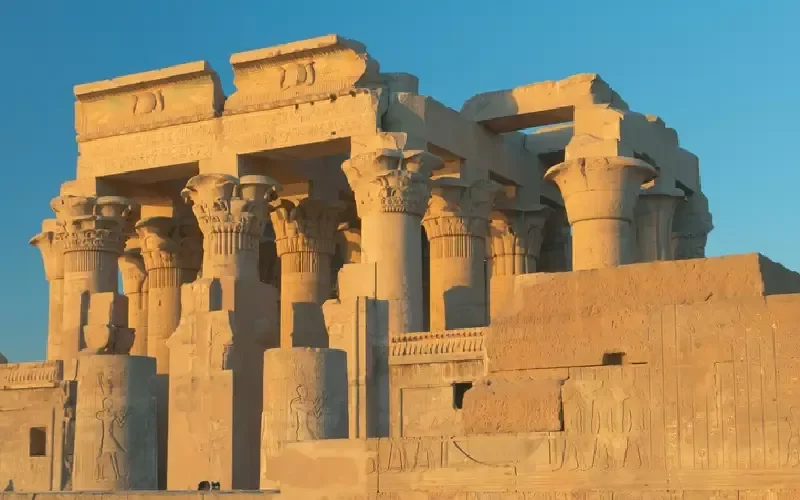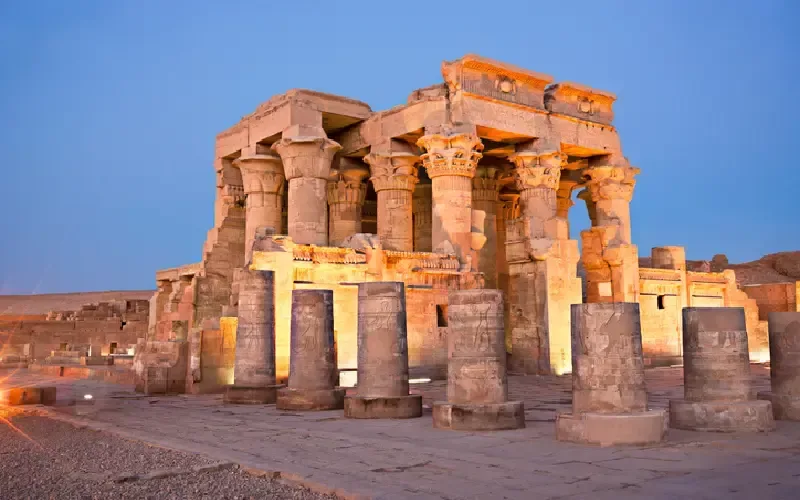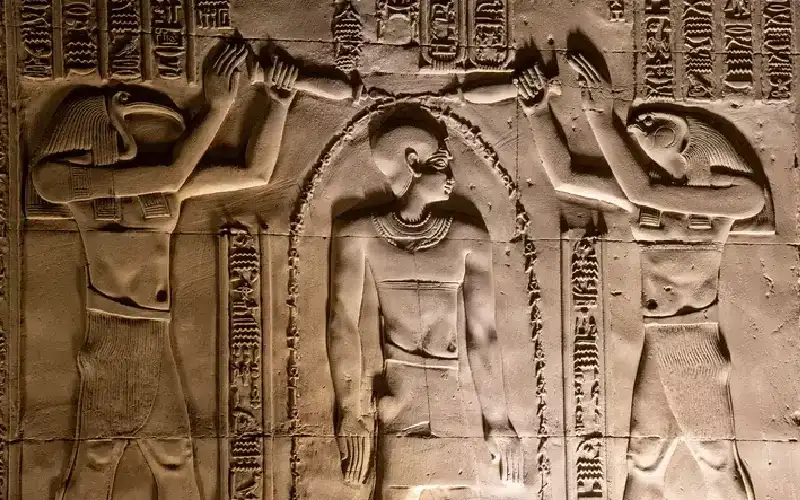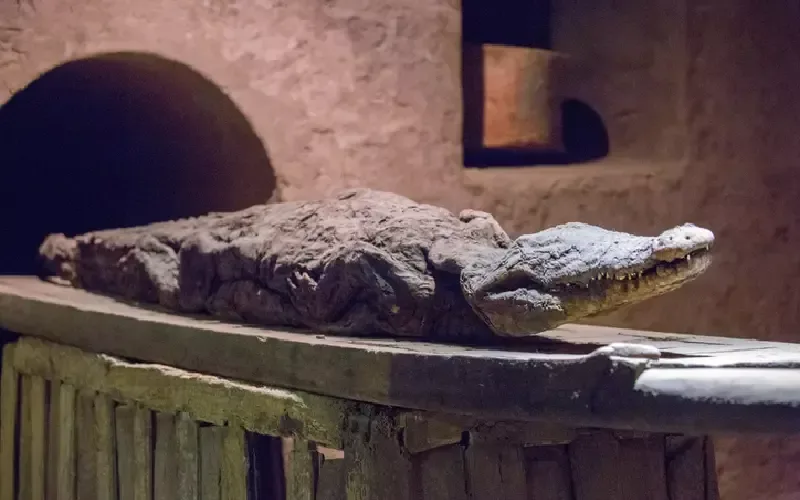Kom Ombo Temple

Kom Ombo Temple is a uniquely symmetrical Egyptian temple built in the 2nd century BC by Ptolemy VI and later expanded by Ptolemy XIII. Unlike typical temples dedicated to a single deity, it was designed as a perfectly mirrored dual sanctuary honoring both Sobek, the crocodile god, and Haroeris (Horus the Elder). Each god had separate entrances, courts, halls, and sanctuaries arranged in flawless balance.
Sobek’s side featured sacred pools where living crocodiles were kept and worshipped as protective divine beings. Over the centuries, the temple suffered extensive damage from Nile floods, earthquakes, and the removal of stones for other construction projects, leaving much of the original structure lost.
The Unique Architecture of Kom Ombo Temple
Ptolemaic architects achieved something unprecedented when they conceived Kom Ombo Temple between 180 BC and 47 BC. Their creation stands as ancient Egypt’s most daring architectural experiment, defying thousands of years of temple-building traditions through its revolutionary dual design. The structure, raised on a high sandstone outcrop overlooking the Nile, catches the sunlight dramatically at dawn and sunset, enhancing its imposing presence. This limestone monument challenges every expectation visitors might hold about Egyptian sacred architecture, blending Greek-influenced symmetry with deeply Egyptian religious symbolism.
A Dual Temple: Sobek and Haroeris
The Temple of Kom Ombo distinguishes itself as the singular Ptolemaic structure dedicated to dual divine households. Architectural planning positioned Sobek’s domain on the southeastern side—symbolically aligned with water, fertility, and the nourishing forces of the Nile. Here, the crocodile-headed deity reigned as guardian of prosperity, fertility, and creation. Sobek’s myths portray him as both protector and destroyer, a god who controlled the unpredictable power of the river.
The northwestern side belonged entirely to Haroeris, the elder form of Horus, associated with justice, light, kingship, and celestial authority. While Sobek represented raw natural power, Haroeris embodied order, protection, and divine kingship—making their dual presence a symbolic reflection of balance between chaos and harmony.
Each side of the temple upheld its own divine family. Sobek’s triad incorporated Hathor and Khonsu, representing motherhood and lunar cycles, while Haroeris’s household included Tasenetnofret (“the Good Sister”) and their son Panebtawy (“Lord of the Two Lands”). This mirroring of families reinforced the temple’s identity as two sanctuaries harmoniously sharing a single sacred structure.
Symmetry in Design and Layout
Kom Ombo’s architects reached architectural perfection through absolute symmetrical precision along a central axis that divides the temple in two. This symmetry was more than an artistic choice—it embodied the Egyptian philosophical concept of Ma’at, the cosmic balance between opposing forces.
Every major architectural element exists in duplicate:
- Two entrances
- Two forecourts
- Two hypostyle halls
- Two inner halls
- Two sanctuaries with matching sacred barque shrines
The entire structure measures roughly 51 meters wide and 96 meters long. Though portions of the roof have collapsed over time, some sections still preserve detailed astronomical ceilings decorated with stars, constellations, and protective vultures.
Columns in the temple carry floral capitals inspired by papyrus, lotus, and palm fronds—symbols of life, rebirth, and divine protection. Many retain traces of their original vibrant color, reminding visitors that ancient temples were once painted in brilliant blues, reds, and golds.
Separate Sanctuaries and Shared Spaces
Despite its dual nature, the temple also includes shared spaces that brought both halves together in a harmonious layout. Both sanctuaries were nearly identical and housed black granite pedestals where sacred barques once rested. A hidden chamber between them served as a symbolic boundary that emphasized their spiritual independence.
The first courtyard, once lined with 16 columns, was accessible to the public during festivals and religious ceremonies. The central open-air altar, still visible today, hosted offerings and the presentation of sacred barques during processions. This area served as a gathering point for prayers and rituals, bridging the divide between the gods’ separate domains.
Overall, Kom Ombo’s architectural plan expressed the profound idea that opposite forces—water and sky, chaos and order, creation and kingship—could coexist in perfect unity.

You will notice that Kom Ombo has distinctive columned halls, detailed relief carvings, and twin entrances leading to its mirrored sanctuaries. The symmetry, combined with its well-preserved Ptolemaic artwork, gives the temple a rare architectural identity.
Historical Timeline of Kom Ombo Temple
Kom Ombo’s history unfolds across multiple eras, each leaving its own imprint on the temple. Though the area shows evidence of earlier settlements dating back to the Predynastic Period, the temple itself reflects the cultural spirit of a later, increasingly multicultural Egypt.
Ptolemaic Origins under Ptolemy VI
Ptolemy VI Philometor initiated construction of Kom Ombo Temple during the 2nd century BCE. His reign marked the beginning of the temple’s great building project. Located near the strategic administrative center of Ombos, Kom Ombo held military and commercial importance, especially due to its proximity to Nubia.
Later rulers expanded the complex:
- Ptolemy VIII added early structures and decorative reliefs
- Ptolemy XII commissioned the grand hypostyle halls
- Ptolemy XIII completed additional components shortly before Cleopatra VII’s era
The use of elephants to transport heavy limestone blocks—mentioned in inscriptions—demonstrates advanced engineering and the influence of Greek and African practices blended during the Ptolemaic period.
Roman Additions and Modifications
After Egypt became a Roman province in 30 BCE, Kom Ombo continued to function as an important religious and administrative center. Roman emperors, seeking to integrate Egyptian religion into their policies of imperial control, sponsored expansions and restorations.
Significant Roman contributions include:
- Augustus’s enclosure walls and expanded courtyards
- An outer corridor encircling the main structure
- Reliefs showing Roman rulers worshipping Egyptian gods
- Artistic programs decorated under Tiberius
Construction persisted into the reign of Emperor Macrinus, demonstrating the temple’s continued prominence even into Late Antiquity.
Coptic Defacement and 19th-Century Restoration
With the rise of Christianity between the 4th and 6th centuries CE, Kom Ombo underwent major religious transformation. Pagan worship was outlawed, and the temple was converted into a church. Christian iconoclasts intentionally defaced divine images, especially those of Sobek.
Centuries of natural damage followed:
- Earthquakes cracked walls
- Heavy Nile floods eroded foundations
- Stone robbers stripped blocks for homes and mills
- Entire structures, such as the Mammisi, disappeared
Renewed interest in the 1800s led French archaeologist Jacques de Morgan to undertake the first major modern restoration in 1893. Later earthquakes, especially the 1992 event, required further repairs, completed in 1995 by the Egyptian Supreme Council of Antiquities.

You’ll find that Kom Ombo Temple was built during the Ptolemaic period, mainly under Ptolemy VI and Ptolemy XII. Its architecture blends Egyptian tradition with Greek influences, reflecting the cultural fusion of that era.
Customize Your Dream Vacation!
Get in touch with our local experts for an unforgettable journey.
Plan Your TripReligious Significance and Temple Rituals
Kom Ombo was more than an architectural marvel—it was a living religious institution. Daily rituals, seasonal festivals, and priestly duties shaped the spiritual life of the region for nearly 500 years.
Role of Sobek and Haroeris in Egyptian Belief
Sobek, the crocodile god, symbolized strength, protection, fertility, and the life-giving power of the Nile. Communities living along crocodile-rich waters honored him for safety and prosperity. Some creation myths describe Sobek as rising from the primeval waters to form the world, reinforcing his association with the Nile’s annual flood.
Haroeris represented justice, rightful kingship, and celestial power. As a form of Horus, he embodied victory over chaos and the divine right of pharaohs. His presence at Kom Ombo reaffirmed the temple’s role in safeguarding political legitimacy and cosmic balance.
Rituals Performed by Priests
Priests in Kom Ombo followed strict daily schedules. Sacred rituals occurred three times a day—morning, midday, and evening—and included:
- bathing and clothing the divine statues
- burning incense and offering perfumes
- presenting food, wine, bread, and flowers
- chanting hymns and reciting protective spells
The Nilometer well, still visible today, allowed priests to measure water levels with scientific precision, essential for agriculture and taxation. These measurements supported the temple’s economic importance throughout the region.
Public Interaction with the Temple
Although ordinary Egyptians could not enter the innermost sanctuaries, they engaged with the temple through festivals, offerings, and petitions. Kom Ombo was widely known as a healing center. Pilgrims carved prayers into walls, left votives, or whispered ailments into sacred recesses designed for confidential appeals to the gods.
The temple’s famed relief of surgical instruments strongly suggests that priests performed medical treatments. This practice blended ritualistic healing with practical medical knowledge, making Kom Ombo one of the earliest spiritual-medical institutions in Egypt.

You’ll understand that Kom Ombo was more than a temple; it was a major religious hub where festivals, processions, and rituals took place. Its dual design allowed worshippers of different deities to gather in the same complex without conflict.
Symbolism in Temple Reliefs and Inscriptions
Kom Ombo’s walls are more than decoration—they are a library carved in stone, preserving one of the richest records of Egyptian ritual, mythology, medicine, and kingship.
Depictions of Surgical Tools and Healing
The renowned medical relief shows scalpels, tweezers, forceps, probes, scissors, and birthing scenes. This rare display combines Roman craftsmanship with Egyptian religious symbolism. The presence of Imhotep, god of medicine, indicates that healing at Kom Ombo was deeply revered and professionally practiced.
Mythological Scenes and Divine Offerings
Royal coronations, offerings, and purification rituals appear throughout the temple. One important relief shows Ptolemy XII receiving his crown from Nekhbet and Wadjet, the protective goddesses of Upper and Lower Egypt. These images reinforced the king’s divine right to rule.
Festival calendars carved into the walls list ceremonies aligned with agricultural cycles, Nile seasons, and astronomical observations.
Astronomical Carvings and the Goddess Nut
The hypostyle hall ceiling depicts Nut arched across the sky, swallowing the sun at dusk and giving birth to it at dawn. This imagery symbolized rebirth and eternal protection for worshippers and the deceased. Her star-filled body also served as a guide for navigating the afterlife.
The Crocodile Connection and Sacred Animals
Kom Ombo is inseparable from its relationship with crocodiles, which played a vital role in Sobek’s worship.
Why Crocodiles Were Sacred to Sobek
Nile crocodiles were apex predators feared and respected by ancient Egyptians. Transforming them into symbols of divine protection ensured spiritual and physical security. Their extraordinary fertility made them powerful emblems of creation and the Nile’s life-sustaining flood.
Mummified Crocodiles and Their Meaning
Priests selected certain crocodiles to live within temple pools, adorned them with gold, and treated them as earthly embodiments of Sobek. After death, the crocodiles were mummified with care, often alongside eggs and fetuses representing rebirth.
Some mummified crocodiles found near Kom Ombo exceed four meters in length, emphasizing their majestic qualities.
The Role of the Crocodile Museum
Established in 2012, the Crocodile Museum preserves 22 of over 300 crocodile mummies discovered in the region. Exhibits include:
- complete crocodile mummies
- crocodile fetuses and eggs
- preserved eyes
- votive offerings
- Sobek statues
The museum offers invaluable insight into crocodile worship and the spiritual significance of Sobek in ancient Egypt.

You’ll see that crocodiles were sacred to Sobek, symbolizing fertility, creation, and the Nile’s power. The temple once kept live crocodiles, and after they died, they were mummified as an act of devotion—many of these mummies are still on display today.
You will find Kom Ombo Temple unique because it is the only ancient Egyptian temple with a perfectly symmetrical double design. Every section—courts, halls, and sanctuaries—is duplicated. The southern side is dedicated to Sobek, the crocodile god, while the northern side honors Haroeris (Horus the Elder).
You can understand that the dual layout reflects the Egyptian belief in balance and harmony between divine forces. The architecture symbolizes the peaceful coexistence of different gods, each with its own role in mythology and daily life.
You will learn that Kom Ombo functioned as an ancient healing sanctuary, where priests acted as physicians. The temple walls show detailed carvings of surgical instruments, proving that both medical treatment and spiritual healing took place here.
You’ll discover that “Kom” means “hill” in Arabic, and “Ombo” comes from an ancient Egyptian word meaning “gold.” Together, “Kom Ombo” translates to “hill of gold,” indicating the site’s historic value and strategic position.
You can see that the temple’s position on a bend of the Nile made it both a strategic lookout point and a sacred site. Its riverside location connected it to Sobek, the crocodile god, who was believed to control the waters and ensure prosperity.
When you look at the reliefs, you’ll find scenes of religious rituals, offerings to Sobek and Haroeris, astronomical depictions, and medical illustrations. These carvings reveal how the ancient Egyptians viewed medicine, religion, and daily life as interconnected.


























